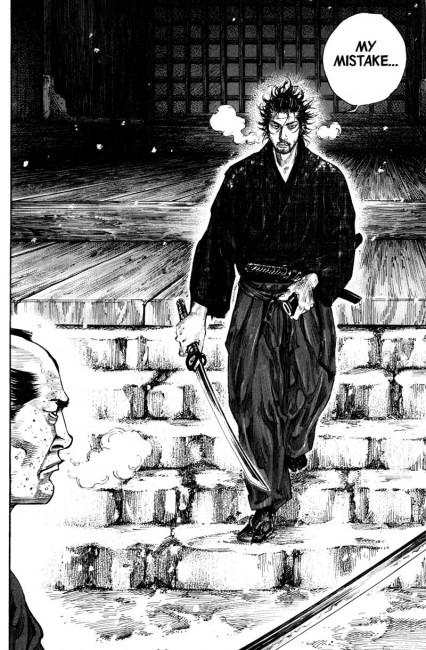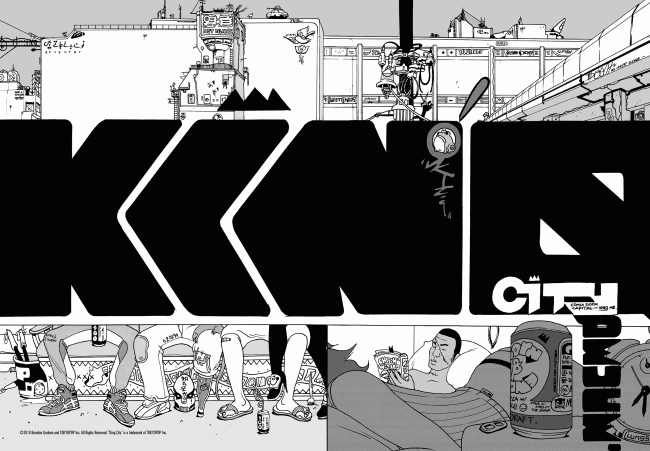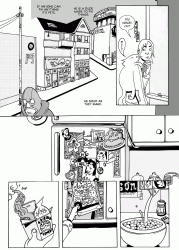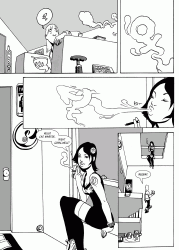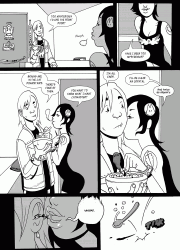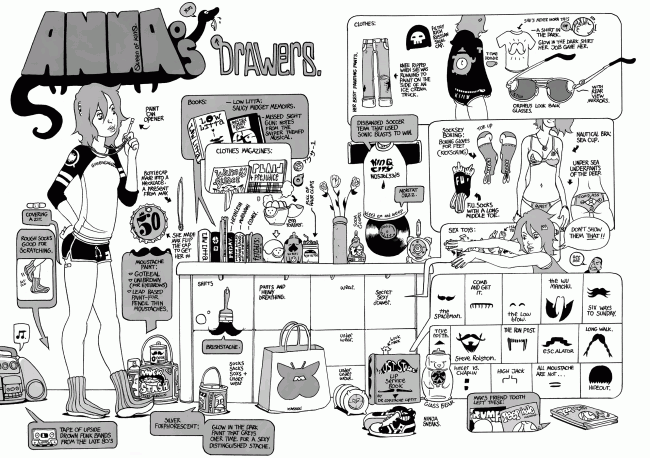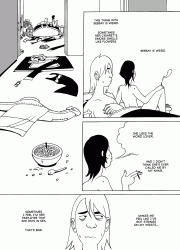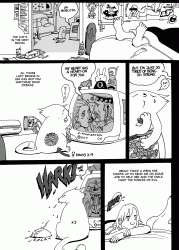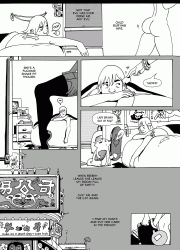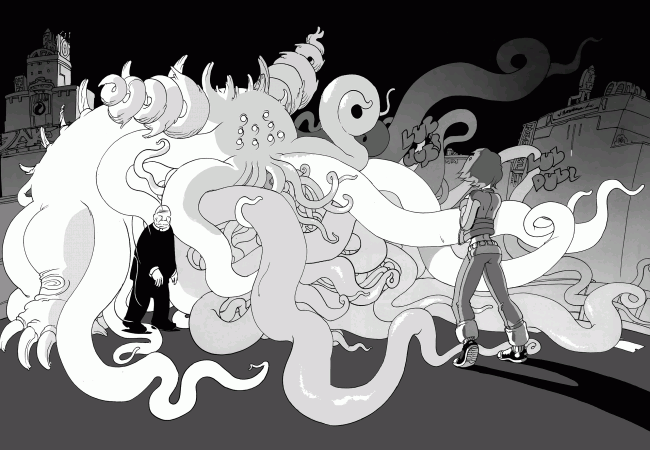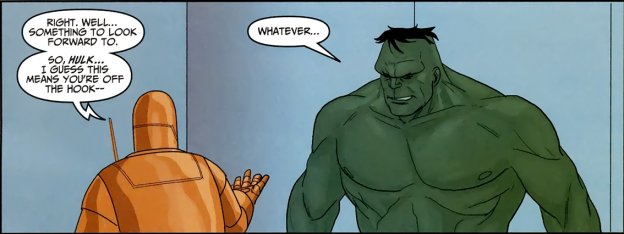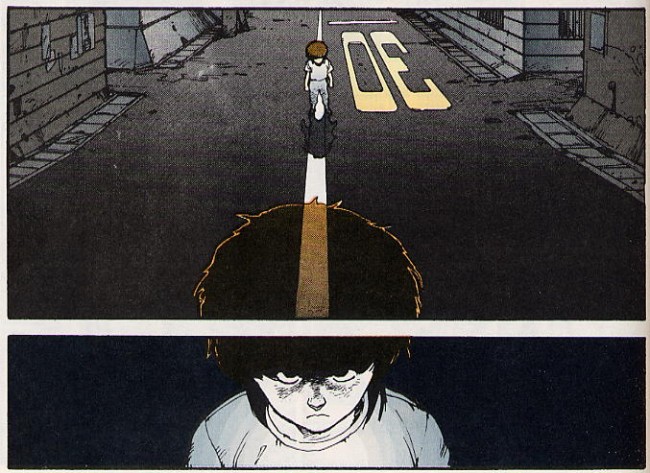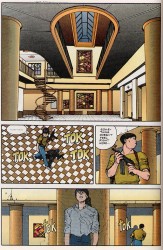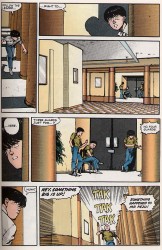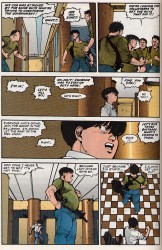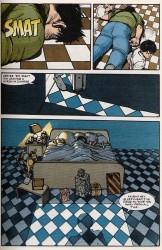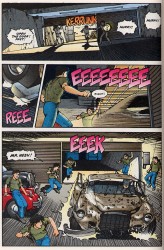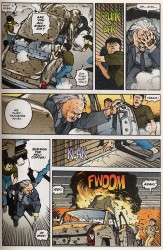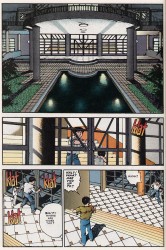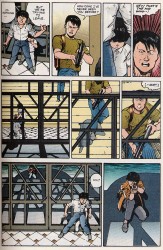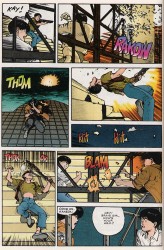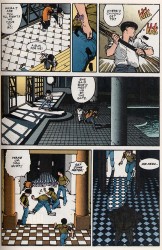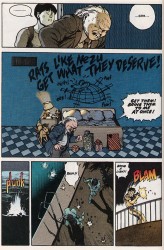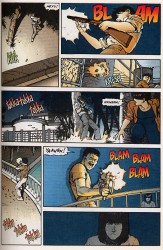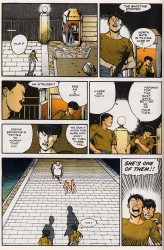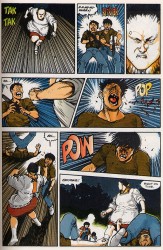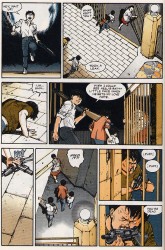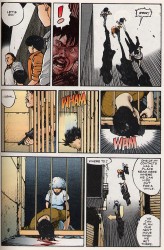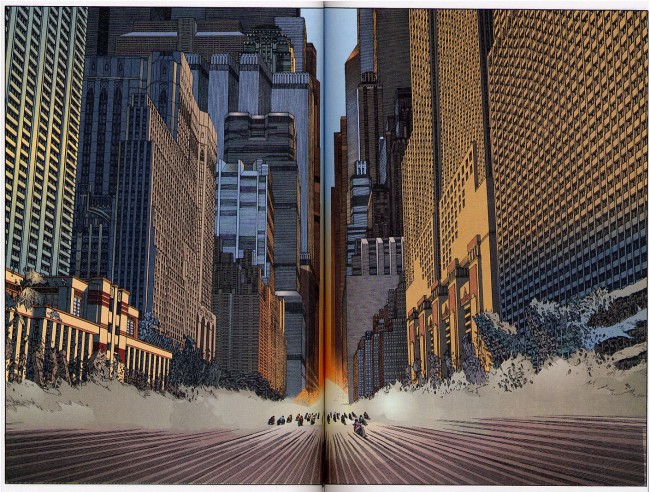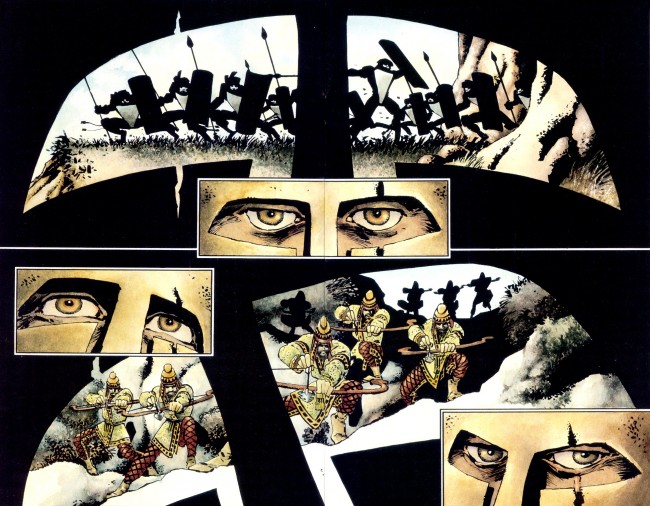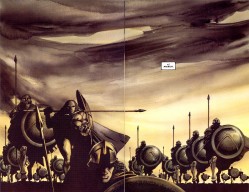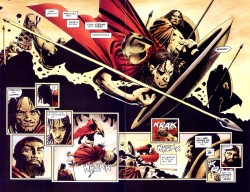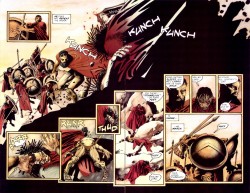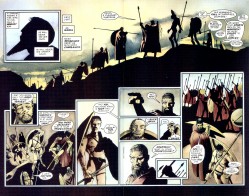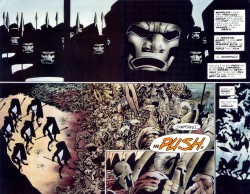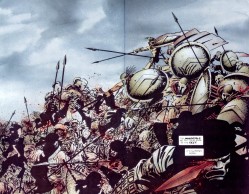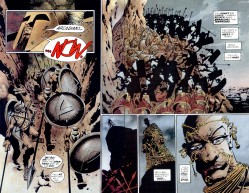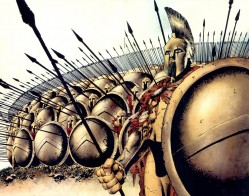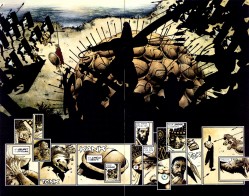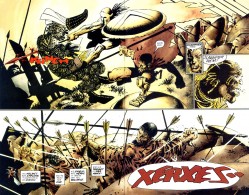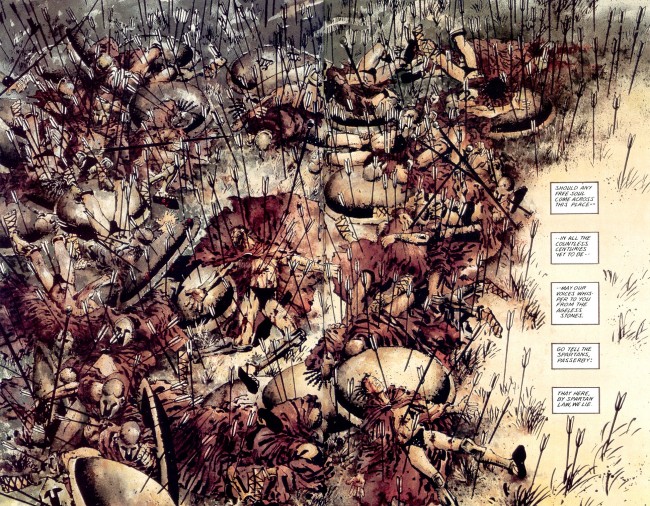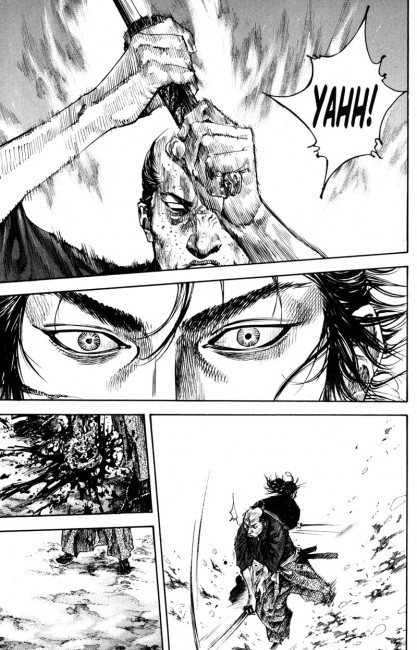
Let me show you the strength of serialized comics.
I don’t mean the usual idea of serialized comics, either. X-Men and Superman are serialized, but they have very short term goals in mind. They aren’t one story, except in the most generous of definitions. I’m talking about one story, released in parts, with each chapter being a vital part of the overall story.
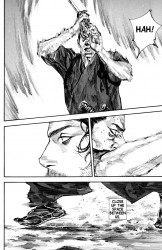
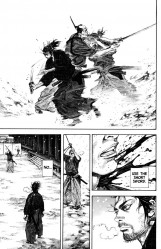
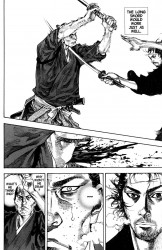
Takehiko Inoue’s Vagabond is a loose adaptation of Eiji Yoshikawa’s Musashi. I could talk about the writing (it’s fantastic) or the art (styles upon styles upon styles is what he has), but I’d rather talk about chapter 215 in Vizbig 8
is a loose adaptation of Eiji Yoshikawa’s Musashi. I could talk about the writing (it’s fantastic) or the art (styles upon styles upon styles is what he has), but I’d rather talk about chapter 215 in Vizbig 8 /Volume 24
/Volume 24 .
.
At the beginning of the story, Miyamoto Musashi is Shinmen Takezo. He grew up under the thumb of a cruel father, and the villagers called him a demon child. He grew up to become just that–a whirlwind of death and violence on the battlefield. He goes off to war and comes back even worse. He decides that he must become Invincible Under the Heavens, and goes out in search of challenges.
He topples everyone he encounters. He eventually runs afoul of the Yoshioka family at one point. They’re one of the most respected sword families, and by challenging them as he did, Musashi disrespected them. His fight with Yoshioka Denshichiro is cut short by a spectacularly poorly-timed fire, and he is challenged to duel him again one year in the future. Den and Musashi are both going to use the time to train and prepare for their battle.
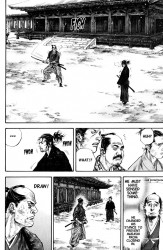
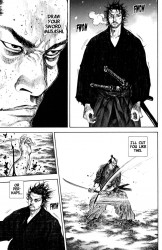
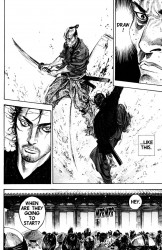
Musashi walks around Japan, looking for challenges and attempting to get better. He destroys all comers, but that isn’t the point of the quest. He has to get better, and getting better doesn’t necessarily mean being the best at swinging a sword. He has to have the poise, experience, and knowledge worthy of a true swordsman.
He meets Sekishusai, one of the greatest swordsmen of the past, and attempts to kill the old man in his sleep. The man’s very presence stops Musashi cold, and their brief conversation completely demolishes Musashi’s idea of skill. He realizes that “invincible” is just a word, and that he has mountains left to climb before he’s as good as he will be.
The challenge was given in what, volume four? Very early on, and in the second Vizbig volume. It’s hard to keep track when you’re reading this series three volumes at a time in the Vizbigs. The second duel begins in the eighth Vizbig volume, 20 normal volumes later. That’s some four thousand pages of story between the challenge and the duel, and we have seen Musashi go through a lot. His idea of swordsman ship has broken down and been rebuilt. He has healed an enemy rather than killing him. He understands what’s worth dying for now. Immediately previous to the duel, he remembered how he approached life as a child, a period of time he spent learning from nature itself. He understands exactly how lucky he has been to survive this long.
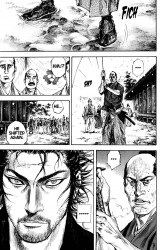
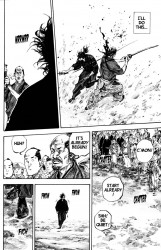
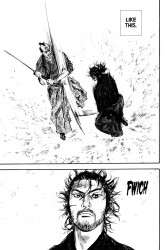
So we have this man, this monster, ready to duel one of the most respected swordsmen in the land. If he beats him, the school’s reputation is ruined. Musashi has a reputation for being wild and violent, but he’s different now. Everyone can see it. They mistake his different nature for a lack of respect and pure over-confidence. Den draws his sword and takes a strong stance.
Musashi begins walking forward.
Scenarios play out across the page. Den and Musashi cross swords and Den’s intestines hit the ground. Except–no, they haven’t met yet. Musashi is still walking. There’s at least fifteen feet between them.
Musashi keeps walking. He begins running through possible encounters in his head. “Use the short sword,” he thinks, and his mind’s eye shows him Den’s throat opening under his blade. “No,” he thinks. “The long sword would work just as well.” Den’s throat opens again.
Den changes his stance. He positions himself so that Musashi cannot rush in. He doesn’t know what’s in Musashi’s mind, but something made him change. Meanwhile, Musashi is still running down scenarios. Den’s hands fall away from his arms after one swing. Another swing takes Den’s left leg around the knee.
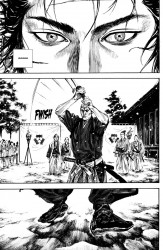
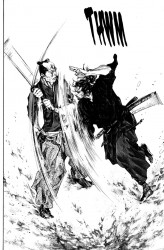
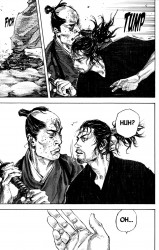
Den’s stance changes again. Musashi is still thinking. A quick slice across the throat. One down the middle, leaving a gash from shoulder to crotch that severs Den’s entire left forearm.
Another stance change.
Musashi kicks off and into Den’s personal space with a fast swing. Den is caught by surprise and flinches, his sword tilting backward and his entire front side left open. Musashi’s body hits Den’s just before his foot touches the ground after his small step. He looks up. Den’s face is strained, but unbloodied. Musashi looks down at his hand.
No sword.
Den shoves him back, knocking him up a set of stairs, and rushes in with an overhead swing. He misses.
Musashi: “No wonder my hands felt so light.” He says, “My mistake,” and finally draws his sword. He steps down from the temple steps and towards Den again. And the duel that has been four thousand pages in the making finally begins.
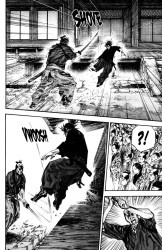
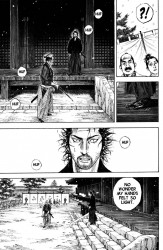
I read this story on my way back from San Diego Comic-con this year. It fell on me like a ton of bricks. Musashi’s growth had been so gradual over the course of the series, coming in fits and starts and never quite spelled out for us, that I missed exactly how much he’d grown. Musashi began as a demon, charging face first into battle and focused only on winning and killing. He had skill, and he had style, but he was like a raw, uncut diamond. He got the job done, but he was ugly and unrefined. He bled killing intent all over the place, striking fear into peasants and making an enemy of every man he met. He was young and brash, and focused merely on being the best.
His year walking around taught him that before being the best, you must first become the best. You have to meditate and learn before you can be the best. There is a process. You have to test yourself and your sword. You have to understand that your sword is an extension of your will and be willing to give yourself over entirely to the sword at the same time. It is a way of life, not some mere accomplishment. Being Invincible Under The Sun means nothing if you aren’t worthy of that title.
And in this chapter, all of that backstory reappeared as weight on my shoulders. Like an overnight sensation who has been working at it for five years, Musashi demonstrated the amazing leap he has made in his swordsmanship. Before, he was a monster. Now, he’s good. He takes Den apart tactically, and the sheer force of his silent contemplation forces Den to adjust his stance and defend. Musashi showed no outward sign of his plans at all. He simply kept walking forward.
He beat Den without a sword in his hand.
The sheer level of growth here is astounding, and the way Inoue demonstrated Musashi’s growth is even more astounding. There’s no exposition, no onlookers explaining what’s going on, or captions filling you in. Den recognizes Musashi’s quiet strength, but everyone else is left in the dark. This is a tremendous payoff, and part of the reason why it’s so tremendous is that you don’t see it coming. You know Musashi’s better. You’ve seen the bloodied bodies he’s left in his wake. You’ve seen him have a play duel with the man who’ll soon be his greatest rival. But when he faces Den, so lost in the battle that he doesn’t even draw his weapon, and still comes through, that’s the moment.
After I finished this chapter, I felt tense. It snuck up on me as I was reading. My brain was working as I read, and when I realized Musashi didn’t draw his blade before striking, I felt genuine shock.
Comic books, man. Sometimes they’re amazing. Vagabond and King City. Brandon Graham and Takehiko Inoue. Their books are good for similar reasons (strong, character-focused storytelling, great art, great world-building) and good for different reasons (Inoue flips styles regularly and prides himself on realism, Graham plays with puns and layouts). Both of them, though, are the kind of books that make you believe in comics. They’re refreshing, they’ve got the kind of punch that comes from telling one story, and they’re just good. They’re the kind of good that’s free of caveats. There’s just one man and his tools, and the result is something beautiful.
